Rule 9 - Conduct of Players and Others Subject to the Rules
SECTION 1. Personal Fouls
All fouls in this section (unless noted) and any other acts of unnecessary roughness are personal fouls. For flagrant personal fouls mandating disciplinary authority review, see Rule 9-6. Except as otherwise noted, the penalties for all personal fouls are as follows:
PENALTY − Personal foul. 15 yards. For dead-ball fouls, 15 yards from the succeeding spot. Automatic first down for fouls by Team B if not in conflict with other rules. Penalties for Team A live-ball personal fouls behind the neutral zone are enforced from the previous spot. Safety if the live-ball foul occurs behind Team A’s goal line. [S7, S24, S25, S34, S38, S39, S40, S41, S45 or S46: PF-*]. Flagrant offenders shall be disqualified [S47: DSQ].
For Team A fouls during free or scrimmage kick plays: Enforcement may be either at the previous spot or, if the scrimmage kick crosses the neutral zone, the spot where the subsequent dead ball belongs to Team B (field goal plays exempted) (Rules 6-1-8 and 6-3-13).
For Team B personal fouls during a legal forward pass play (Rules 7-3-12 and 10-2-2-e): Enforcement is at the end of the last run when it ends beyond the neutral zone and there is no change of team possession during the down. If the pass is incomplete or intercepted, or if there is a change of team possession during the down, the penalty is enforced at the previous spot.
Article 1 - Flagrant Personal Fouls
Before the game, during the game and between periods, all flagrant personal fouls (Rule 2-10-3) require disqualification. Team B flagrant personal fouls require first downs if not in conflict with other rules.
Article 2 - Striking Fouls and Tripping
No player shall target and make forcible contact against an opponent with the crown of his helmet. The crown of the helmet is the portion of the helmet above the level of
the top of the facemask. This foul requires that there be at least one indicator of targeting (see Rule 2-35). When in question, it is a foul (Rule 9-6). (A.R. 9-1-3:I)
PENALTY − Flagrant foul. In addition to the 15-yard penalty, automatic disqualification. The 15-yard penalty is not enforced if the video judge reverses the disqualification. [S38, S24 and S47: PF-TGT/DSQ]
Article 3 - Targeting and Making Forcible Contact With the Crown of the Helmet
No player shall target and make forcible contact against an opponent with the crown of his helmet. The crown of the helmet is the portion of the helmet above the level of the top of the facemask. This foul requires that there be at least one indicator of targeting (see Rule 2-35). When in question, it is a foul (Rule 9-6). (A.R. 9-1-3:I)
PENALTY − Flagrant foul. In addition to the 15-yard penalty, automatic disqualification. The 15-yard penalty is not enforced if the video judge reverses the disqualification. [S38, S24 and S47: PF-TGT/DSQ]
Article 4 - Targeting and Making Forcible Contact to Head or Neck Area of a Defenseless Player
No player shall target and make forcible contact to the head or neck area of a defenseless opponent with the helmet, forearm, hand, fist, elbow or shoulder. This foul requires that there be at least one indicator of targeting (see Rule 2-35). When in question, it is a foul (Rule 2-27-14 and 9-6). (A.R. 9-1-4:I-VI)
PENALTY − Flagrant foul. In addition to the 15-yard penalty, automatic disqualification. The 15-yard penalty is not enforced if the video judge reverses the disqualification. [S38, S24 and S47: PF-TGT/DSQ]
Article 5 - Clipping
There shall be no clipping (Rule 2-5).
Exceptions:
1. Offensive players who are on the line of scrimmage at the snap within the free- blocking zone (Rule 2-3-6) legally may clip in the free-blocking zone, subject to the following restrictions:
(a) A player in the free-blocking zone may not block an opponent with the force of the initial contact from behind and at or below the knee.
(b) A player on the line of scrimmage within the free-blocking zone may not leave the zone and return and legally clip.
(c) No player may violate Rule 9-1-6 (Blocking Below the Waist).
NOTE: The free-blocking zone disintegrates when the ball leaves the zone (Rule 2-3-6).
2. When a player turns his back to a potential blocker who has committed himself in intent and direction of movement.
3. When a player attempts to reach a ball carrier or simulated ball carrier or attempts to legally recover or catch a fumble, a backward pass, a kick or a touched forward pass, he may push an opponent below the waist at or to the buttocks (Rule 9-3-6 Exception 3).
4. When an eligible player behind the neutral zone pushes an opponent below the waist at or to the buttocks to get to a forward pass (Rule 9-3-6 Exception 5).
5. Clipping is allowed against the ball carrier or simulated ball carrier.
Article 6 - Blocking Below the Waist
a. Team A prior to a change of team possession:
Linemen with initial position completely inside the tackle box may legally block below the waist inside the tackle box or the free-blocking zone until the ball leaves the tackle box. All other Team A players are allowed to block below the waist only if the force of the initial contact is directed from the front. "Directed from the front" is defined as within the clock face region between "10 o’clock and 2 o’clock" forward of the area of concentration of the player being blocked.
Exceptions:
1. Team A players may not block below the waist when the block occurs five yards or more beyond the neutral zone.
2. Players outside the tackle box at the snap or any time after the snap, or who are in motion at the snap may not block below the waist toward the original position of the ball at the snap.
3. Once the ball has left the tackle box, a player may not block below the waist toward his own end line.
b. Team B prior to a change of team possession:
1. Other than in paragraphs 2 and 3 (below), players of Team B may block below the waist only within the area defined by lines parallel to the goal line five yards beyond and behind the neutral zone extended to the sidelines. To be legal, this block must be directed from the front. Blocking below the waist by players of Team B outside this zone is illegal except against the ball carrier. (A.R. 9-1-6:VI, IX)
2. Players of Team B may not block below the waist against an opponent who is in position to receive a backward pass.
3. Players of Team B may not block below the waist against an eligible Team A pass receiver beyond the neutral zone unless attempting to get to the ball or ball carrier. This prohibition ends when a legal forward pass is no longer possible by rule.
c. Kicks:
During a down in which there is a free kick or scrimmage kick, blocking below the waist by any player is illegal except against a ball carrier.
d. After change of team possession:
After any change of team possession, blocking below the waist by any player is illegal except against a ball carrier.
e. Clipping. No player may violate Rule 9-1-5 (Clipping).
Article 7 - Late Hit, Action Out of Bounds
a. There shall be no piling on, falling on, or throwing the body on an opponent after the ball becomes dead. (A.R. 9-1-7:I)
b. No opponent shall tackle or block the ball carrier or simulated ball carrier when he is clearly out of bounds or throw him to the ground after the ball becomes dead.
c. It is illegal for any player to be clearly out of bounds when he initiates a block against an opponent who is out of bounds. The spot of the foul is the point on the sideline nearest to where the contact occurs.
Article 8 - Helmet and Face Mask Fouls
a. No player shall continuously contact an opponent’s face, helmet (including the face mask) or neck with hand(s) or arm(s) (Exception: By or against the ball carrier or simulated ball carrier). [S26: PF-HTF] b. No player shall grasp and then twist, turn or pull the face mask, chin strap or any helmet opening of an opponent. It is not a foul if the face mask, chin strap or helmet opening is not grasped and then twisted, turned or pulled. When in question, it is a foul.
Article 9 - Roughing the Passer
a. No defensive player shall unnecessarily rough a forward passer when it is obvious the ball has been thrown. Illegal actions include but are not limited to:
1. Targeting fouls as noted in 9-1-3 and 9-1-4.
2. Forcible contact to the head or neck area that does not meet the requirements of Rule 9-1-4 (also reference Rule 9-1-2).
3. Forcible contact that is avoidable after it is obvious the ball has left the forward passer’s hand. (Exception: A defensive player who is blocked by a Team A player(s) with a force so that he has no opportunity to avoid contact with the forward passer. However, this does not relieve the defensive player of responsibility for personal fouls as described elsewhere in this section.)
4. Forcibly driving the forward passer to the ground and landing on him with action that punishes the player.
5. Any action that is a personal foul as described elsewhere in this section.
b. When an offensive player is in a passing posture with one or both feet on the ground, no defensive player rushing unabated shall hit him forcibly at the knee area or below. The defensive player also may not initiate a roll or lunge and forcibly hit this opponent in the knee area or below.
Exceptions:
1. It is not a foul if the offensive player is a ball carrier or simulated ball carrier not in a passing posture, either inside or outside the tackle box.
2. It is not a foul if the defender grabs or wraps this opponent in an attempt to make a conventional tackle without making forcible contact with the head or shoulder.
3. It is not a foul if the defender is not rushing unabated or is blocked or fouled into this opponent.
PENALTY − The 15-yard penalty is added to the end of the last run when it ends beyond the neutral zone and there is no change of team possession during the down. (A.R. 9-1-9:II-III)
Article 10 - Chop Blocking
Article 11 - Leverage and Leaping
a. No defensive player, in an attempt to gain an advantage, may step, jump or stand on an opponent.
b. It is a foul if a defensive player moves forward and tries to block a kick or apparent kick on a field goal or try by leaving his feet and leaping into the plane directly above the frame of the body of an opponent. It is not a foul if the player was aligned in a stationary position within one yard of the line of scrimmage when the ball was snapped.
c. It is a foul if a defensive player who is inside the tackle box tries to block a punt or an apparent punt by leaving his/her feet and leaping into the plane directly above the frame of the body of an opponent.
1. It is not a foul if the player tries to block the punt by jumping straight up without attempting to leap over the opponent.
2. It is not a foul if a player leaps through or over the gap between players.
d. No defensive player, in an attempt to block, bat or catch a kick or apparent kick, may:
1. Step, jump or stand on a teammate.
2. Place a hand(s) on a teammate to get leverage for additional height.
3. Be picked up by a teammate, or be elevated, propelled or pushed.
PENALTY − 15 yards, previous spot and automatic first down. [S38: PF-LEA]
e. No player may position himself with his feet on the back or shoulders of a teammate before the snap.
PENALTY − Dead-ball foul. 15 yards from the succeeding spot. Automatic first down for fouls by Team B if not in conflict with other rules [S27: UC-UNS].
Article 12 - Leverage and Leaping
a. No player shall tackle or run into a receiver when a forward pass to that receiver is obviously not catchable. This is a personal foul and not pass interference.
b. No player shall run into or throw himself against an opponent obviously out of the play either before or after the ball is dead.
Article 13 - Leverage and Leaping
Article 14 - Leverage and Leaping
Article 15 - Leverage and Leaping
All players are prohibited from grabbing the inside back collar of the shoulder pads or jersey, the nameplate area of the jersey or above, or the inside collar of the side of the shoulder pads or jersey, and pulling the ball carrier or simulated ball carrier toward the ground. This does not apply to a ball carrier or simulated ball carrier, including a potential forward passer, who is inside the tackle box (Rule 2-34). Note that the tackle box disintegrates when the ball leaves it.
NOTE: It is not necessary for a player to pull the opponent completely to the ground in order for the act to be illegal. If the opponent’s knees are buckled by the action, it is a foul even if he is not pulled completely to the ground.
Article 16 - Roughing or Running into Kicker or Holder
a. When it is obvious that a scrimmage kick will be made, no opponent shall run into or rough the kicker or the holder of a place kick. (A.R. 9-1-16:I, III and VI)
1. Roughing is a live-ball personal foul that endangers the kicker or holder.
2. Running into the kicker or holder is a live-ball foul that occurs when the kicker or holder is displaced from his kicking or holding position but is not roughed. (A.R. 9-1-16:II)
3. Incidental contact with a kicker or holder is not a foul.
4. The kicker’s protection under this rule ends:
(a) When he has had a reasonable time to regain his balance (A.R. 9-1-16:IV); or
(b) When he carries the ball outside the tackle box (Rule 2-34) before kicking.
5. When a defensive player’s contact against the kicker or holder is caused by an opponent’s block (legal or illegal), there is no foul for running into or roughing.
6. A player who makes contact with the kicker or holder after touching the kick is not charged with running into or roughing the kicker.
7. When a player other than one who blocks a scrimmage kick runs into or roughs the kicker or holder, it is a foul.
8. When in question whether the foul is running into or roughing, the foul is roughing.
PENALTY − Roughing or any other personal foul against the kicker who is in the act of or just after kicking the ball: 15 yards from the previous spot, plus automatic first down if not in conflict with other rules [S38 and S30: PF-RTK/PF-RTH]. Running into the kicker: five yards from the previous spot [S30: RNK/RNH].
b. A kicker or holder simulating being roughed or run into by a defensive player commits an unsportsmanlike act. (A.R. 9-1-16:V)
PENALTY − 15 yards from the previous spot [S27: UC-SBR].
c. The kicker of a free kick may not be blocked until he has advanced five yards beyond his restraining line, or until the ball has touched a player, an official or the ground.
PENALTY − 15 yards from the previous spot [S40: PF-RTK].
Article 17 - Continued Participation Without Helmet
Article 18 - Blind-side block
No player shall deliver a blind-side block by attacking an opponent with forcible contact. (Exceptions:
1. the ball carrier or simulated ball carrier;
2. a receiver in the act of attempting to make a catch.)
NOTE: In addition, if this action meets all the elements of targeting, it is a blind-side block with targeting 9-1-3 and 9-1-4.



